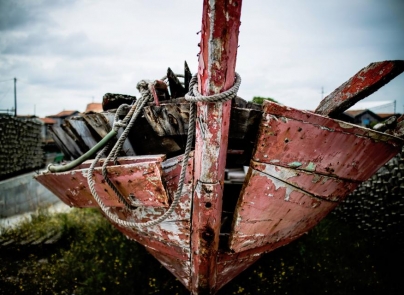Krishna Pal – The First Baptist Convert in India

Krishna Pal – The First Baptist Convert in India
On November 25, 1800, a 36-year-old Indian carpenter named Krishna Pal slipped into the tank where he was going to bathe, dislocating his shoulder. Having heard about a doctor at the Baptist mission at Serampore, not far from his house, he sent two of his children to ask for help.
They returned with John Thomas, a physician who had joined William Carey in his early mission to India. But Thomas didn’t just set the man’s arm. He also spoke to him about the worse disease of sin and the remedy God had provided in Christ.
It was the perfect time. Pal had been unsatisfied with the answers provided by local religions – in spite of several years spent with the Kharta-bhojas sect and sixteen years with the Ghospara sect, where he was a teacher. Most recently, he had heard the gospel from some Moravian missionaries, but they had left, discouraged by the unresponsiveness of the local people. Hearing the gospel again from Thomas moved Pal to tears.
Thomas told him to take some time to reflect on a short rhyme: “Sin confessing, sin forsaking, Christ’s righteousness embracing, the soul is free.”[1] This resonated with Pal, who was familiar with the use of mantras to reflect on spiritual truths.
Later that day, Thomas visited Pal again, together with Joshua Marshman, another member of the Serampore mission. They asked how he was and they left him with some tracts in Bengali. Describing one of those, Pal wrote, “In this paper I read that he who confesseth and forsaketh his sins and trusteth in the righteousness of Christ obtains salvation.”[2]
The Making of a Bengali Christian Community
The missionaries, including William Carey, his son Felix, and William Ward, continued to visit Pal, giving him some medicine for his pain and reading and explaining the Bible to him. When Thomas asked him what he understood from what they had been teaching, Pal said that the Lord Jesus Christ gave his life up for the salvation of sinners, and that he believed it.
And Pal was not the only one. His neighbor Gokool and the women and children in the two households had also understood the missionaries’ message. “The women appeared to have learned more of the gospel than we expected,” Ward wrote on December 6 in The Mission Journal. “They declared for Christ at once. This work was new, even to brother Carey. A whole family desiring to hear the gospel, and declaring in favour of it! Pal's wife said she had received great joy from it.”
“To have natives who feel a little as we do ourselves,” Ward wrote four days later, “is so new and different. The country itself seems to wear a new aspect to me.”[3]
This opened a new chapter in the Serampore mission. These missionaries (especially Carey and Thomas) had been in Bengali for years without a convert, and Carey had almost lost hope. “And after all,” Ward continued, “God has done it with perfect ease! Thus the door of faith is open to the gentiles; who shall shut it? The chain of the caste is broken; who shall mend it?”[4]
But Pal’s conversion came at a cost for him and his family. When the missionaries’ servants began to spread the news that Pal and Gokool were eating with Europeans, openly renouncing their caste, the whole neighborhood (two thousand people) gathered to curse the new converts. They even brought them to the magistrate on charges the judge found unsubstantial.
On December 28 – seven years after Carey’s arrival in India – Pal was baptized in the Hooghly River. Other people later followed his footsteps. Jeymooni, the sister of Pal’s wife Rasoo, was the first Bengali woman to be baptized. Rasoo was the second. Gokool hesitated for a while, unable to convince his wife, but they were finally persuaded with the help of Pal and his family. Soon, his sisters Onunda and Kesaree were also baptized, as the Bengali Christian community continued to grow. By 1821, 1400 Indians had been baptized. Contrary to some expectations, most of these converts came from respectable castes, including some Brahmins.
Preacher and Poet
In 1802, in a letter to the Bible Society, Pal wrote of how he learned, first through Thomas and then through other missionaries, that “sinners becoming repentant, through the sufferings of Christ, obtain salvation.”
“In this rejoicing, and in Christ's love believing, I obtained mercy,” he continued. “Now it is in my mind continually to dwell in the love of Christ: this is the desire of my soul. ... Now this word I will tell to the world. Going forth, I will proclaim the love of Christ with rejoicing. To sinners I will say this word: Here sinner, brother! Without Christ there is no help. Christ, the world to save, gave his own soul! Such love was never heard: for enemies Christ gave his own soul!”[5]
With this vision, he built a church in front of his house. There, he preached his first sermon to twenty natives besides his family. This was the beginning of a 20-year preaching ministry, with as many as 14 sermons per week in Calcutta and its surroundings (which included Serampore).
Carey described one of Pal’s early sermons as “fluent, perspicuous, and affectionate, in a very high degree.”[6] In a later letter, he called Pal a “zealous, well-informed, and I may add, eloquent minister of the gospel.”[7]
Besides preaching and distributing tracks, Pal wrote several hymns in Bengali. The most famous of these was translated into English by Marshman:
Thou, my soul, forget no more,
The Friend who all thy misery bore;
Let every idol be forgot,
But, my soul, forget HIM not.
Bruhha[8] for thee a body takes,
Thy guilt assumes, thy fetters breaks,
Discharging all thy dreadful debt; —
And canst thou e'er such love forget?
Renounce thy works and ways with grief.
And fly to this most sure relief;
Nor Him forget who left his throne,
And for thy life gave up his own.
Pal died in 1822, at about 58 years of age, after a long and fruitful ministry. His story inspired many missionaries to venture to India, a country many had considered closed to the gospel.
[1] Michael A. G. Haykin, “Just Before Judson. The Significance of William Carey’s Life, Thought, and Ministry,” in Jason G. Duesing, ed., Adoniram Judson: A Bicentennial Appreciation of the Pioneer American Missionary, Nashville, Tennessee: B&H Publishing Group, 2001, p. 27
[2] The First Hindoo Convert: A Memoir of Krishna Pal, a Preacher of the Gospel to His Countrymen More Than Twenty Years, American Baptist Publication Society, 1852, 10
[3] Ibid., 12
[4] Ibid., 12
[5] Ibid., 21
[6] Haykin, “Just Before Judson”, 27
[7] Ibid.
[8] Jesus





